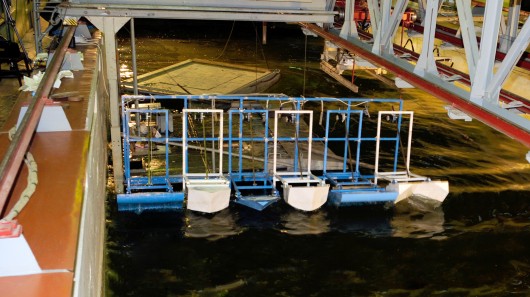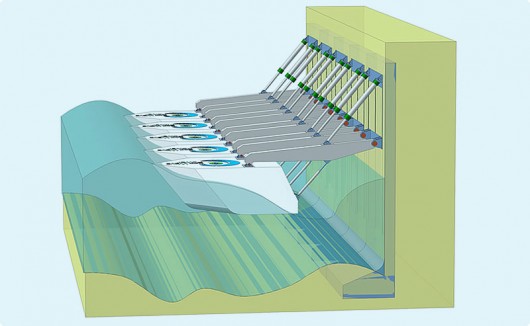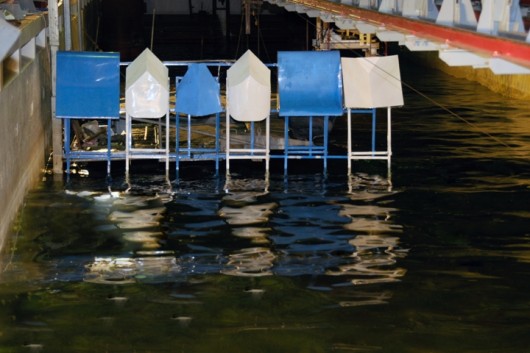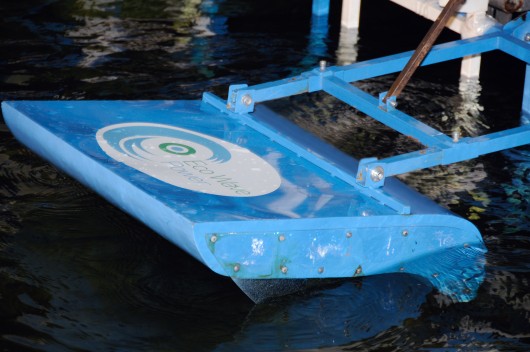
Eco Wave Power developing two new wave-power devices
srael’s Eco Wave Power is just entering the second phase of proving its new wave energy harvest and conversion system that’s claimed to produce cheaper energy than existing coal-fired power plants. Energy is captured by the influence of rising and falling waves on two proprietary float designs called the Wave Clapper and Power Wing, which are installed on existing, stable structures. The floats are said to be capable of gathering energy from both high and low waves, which is fed through undersea cabling to a land-based power plant for conversion to usable electricity.
In addition to setting its sights on being cheaper than coal-fired power plants, David Leb’s Eco Wave Power (EWP) is aiming at beating natural gas, offshore wind, solar, and any other green technology, too. The company has completed the first small scale proof of concept system in the wave pool of the Ukraine’s Institute for Hydromechanics in Kiev, and is now moving onto a medium scale version which will be 40 times bigger (in terms of volume) than the first. From there, the company will construct a full size, commercial scale plant and then, if all goes as expected, out into the world at large.

Unlike other wave energy technologies, the harvesting part of the EWP system makes use of existing, stable structures such as breakwaters, piers and floating and fixed platforms (but is also said to be flexible enough to be adjusted for mobility in areas where such structures are not available or in short supply). The company has developed two different shapes of float/buoy to sit at the surface of the water as it rises and falls, which are connected to the supporting structure via robust hydraulic arms.
Where space is limited, the Wave Clapper design is deployed – which is pointed at the front like the bow of a ship and can be positioned in series with little space in between. In marine environments which require versatility, the Power Wing – which can operate at different wave heights – will be the float of choice. The unique shaping of each is not incidental, the company says that this is the result of careful study of existing wave energy systems and allows its design to generate power from both change of water level and from incident flow.
To ensure maximum energy from each wave that hits the float, EWP proposes automatically adjusting the angle of the buoy so that its front edge is always parallel to the wave front for the maximum amount of time. Various deployment configurations are also suggested, including a line arrangement for areas with a stable annual wave amplitude, the staggering of buoys for areas with high wave amplitudes, and the placement of small floats behind larger ones to cope with areas known for frequent changes in wave behavior.
The EWP system is equipped with sensors that continually monitor the surrounding ocean environment, and is programmed to recognize an upcoming storm and automatically adjust the position of the buoys to protect them from damage. Mechanical, pneumatic or hydraulic dampers can also be implemented to further protect the system against particularly volatile sea conditions.
The hydro cylinder is said to act as both a delivery pump and hydraulic lift that can raise the Wave Clapper or Power Wing floats out of the water. There are also occasions when it’s safer to submerge the buoys and this is achieved by opening a flood valve and allowing the buoy to fill with water until it sinks down of its own accord. Once the storm has passed, they’re returned to their working positions and energy capture, conversion and transmission to shore recommences.
Only the floats and pistons are located on the water, the oil tanks and hydro pneumatic equipment are land-based – which not only lends itself to ease of maintenance and quick repair but is also said to significantly reduce the potential pollution risks of wholly sea-based systems. This machinery then converts the wave motion into fluid pressure, which turns a generator and produces electricity, with monitoring and control systems in place to regulate the flow of energy to and from the converter.
“The medium scale device will produce a minimum of stable 5 kWh from each floater, which means 10 kWh from both at all given times, resulting in 240 kWh a day and a yearly amount of 87,600 kWh (with wave height up to 1.5 meters/4.9 ft),” Leb told Gizmag. “Immediately after the testing of our medium-scale model has been completed, we will build the commercial scale power plant. This will be a full scale device, capable of providing stable and cost-efficient electricity to at least 1,000 households. In terms of size, the volume of each floater will be 20,000 Liters, enabling a stable output of at least 90 kWh from each floater, which equals to a daily amount of 2,160 kWh and a yearly amount of 788,400 kWh from one floater (if utilized 100 percent of the time).”
Once the three proofing phases are completed, the company will look towards the large scale roll out of its patented technology. Engineers and technicians from EWP will undertake feasibility studies of locations and in-depth examination and analysis of the proposed site ahead of installation. The land-based equipment and Wave Clapper/Power Wing buoys will be designed specifically for the area in which they’ll be deployed. Additionally, the scalable and flexible system is said to benefit from corrosion protection processes that result in an operational lifespan in excess of 30 years.
“At this point the company has sufficient funding to get to the commercial scale device, and beyond,” says Leb. “We want to reach to the point of having a proven technology, in order to raise money for higher evaluation. We assume that we will start raising funds at later stages for further development of our final product, as well as for the execution of large scale construction agreements with electric utility companies.”
The following video shows the small scale proof of concept system in operation:
VIEW HERE



